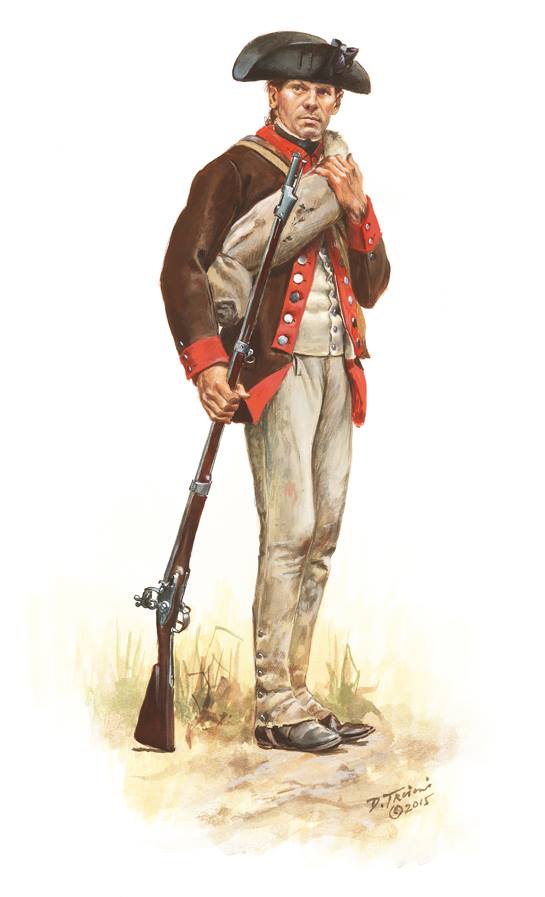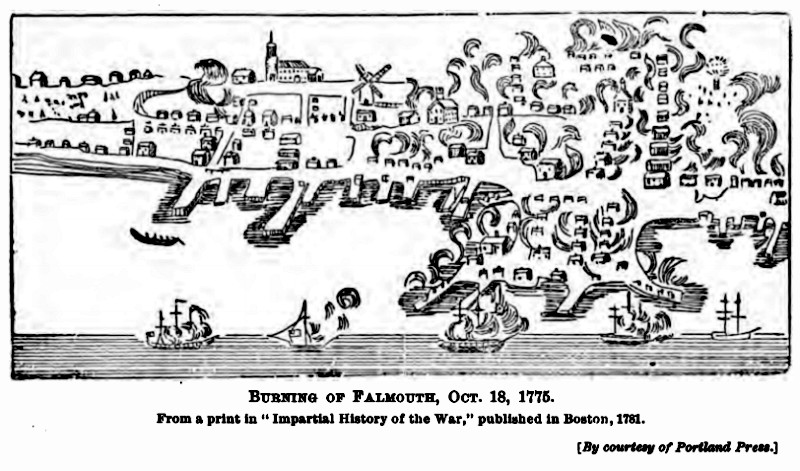The Revolutionary War
Grievances against the British crown would lead to the outbreak of hostilities in 1775.
Continental Army Regiments
News of the Battle of Lexington on April 19, 1775 reached York that evening and Captain Johnson Moulton and over 60 men marched on the morning of April 20 toward Boston. This was the first company that marched from the Province of Maine in the Revolution. The York County Regiment mustered at the same time, under Colonel James Scamman as the 30th Regiment of Foot, with companies from York, Kittery, Berwick, Wells, Biddeford, and Saco. Scamman’s Regiment arrived in Cambridge, Massachusetts on May 23. They were present for the Battle of Bunker Hill but due to incorrect orders, did not take part in the fighting. Two men of the regiment were wounded, however. The regiment served through the siege of Boston until the end of December, 1775 when their enlistments ran out. The majority of the regiment reenlisted, with six companies being consolidated with Colonel Phinney’s Cumberland Regiment.
On April 23, the Cumberland County Regiment of Militia under Colonel Edmund Phinney was mustered into service as the 31st Regiment of Foot. They arrived in Boston in June. They participated in the siege of Boston through 1775 and into 1776. On January 1, they were designated the 18th Continental Regiment. The regiment was part of a body of 4,000 picked troops being prepared to storm Boston in March of 1776, before the British evacuated.
On July 9, the regiment was ordered to march to Lake Champlain, one of four regiments from Washington’s army in Boston being sent as reinforcements. The regiment began its march on August 8, arriving at Mount Independence, Vermont on September 2. While at Mount Independence, the men of the regiment assisted in constructing fortifications for that site as well as at Fort Ticonderoga across the channel. They stood-to for various alarms and at the approach of the British fleet following the Battle of Valcour Island. However, the defenses at Fort Ticonderoga and Mount Independence deterred the British from attacking and the campaign season of 1776 came to a close. The regiment did not know it yet, but their defense of the Lake Champlain corridor had given the Continental cause another year of life – a year that would prove definitive for the revolution.
Fort Ticonderoga, left, and Mount Independence, right. Artist's visualization.
During November, Colonel Phinney assumed command of Fort George and the regiment had the responsibility for moving supplies from Fort George to the other forts on the front lines. At the end of 1776, the enlistments for the regiment again ran out. Over 100 men reenlisted into the new organization, the 12th Massachusetts Regiment of the Continental Line, under the command of Colonel Samuel Brewer. This regiment returned to Fort Ticonderoga in the spring of 1777. It was involved in skirmishing in early July and then fell back with the rest of the Northern Army when Fort Ticonderoga and Mount Independence were abandoned in the face of superior British forces.
The 12th Mas sachusetts was present for the Battles of Freeman’s Farm and Saratoga, a decisive American victory in October of 1777. The soldiers witnessed the first surrender of a British field army in the war. This helped bring about foreign intervention which was crucial to American victory. Following Saratoga, the regiment marched south to join Washington’s Army outside Philadelphia. They were part of the incredibly grueling winter quarters at Valley Forge.
sachusetts was present for the Battles of Freeman’s Farm and Saratoga, a decisive American victory in October of 1777. The soldiers witnessed the first surrender of a British field army in the war. This helped bring about foreign intervention which was crucial to American victory. Following Saratoga, the regiment marched south to join Washington’s Army outside Philadelphia. They were part of the incredibly grueling winter quarters at Valley Forge.
Following Valley Forge, the 12th Massachusetts took part in the campaigns in Pennsylvania and New Jersey that summer, including the Battle of Monmouth were they were engaged as part of the reserve. The regiment suffered killed and wounded in this encounter. From 1778 to 1781, the regiment was part of the forces around West Point, New York. It was mustered out in 1781, after six years of consecutive service.
Operations in Maine
The first naval battle of the war took place in Machias, when local militia boarded and seized the armed sloop HMS Margaretta on June 12, 1775. In this small ship-to-ship action, two Americans and four British servicemembers were killed. This incident is known as the “Lexington of the Sea.” Before the engagement, two young women – Hannah and Rebecca Weston – traveled 16 miles to bring metal for ammunition to support the operation.
In 1775, the town of Falmouth (now Portland) was targeted by the British as being a hotbed of rebel sympathizers. British Royal Navy Captain Henry Mowatt sailed into the harbor with several ships of war and sent an ultimatum to the local militia leaders: all weapons were to be turned over to the British by nightfall or the town would be burnt. The heroic town and militia leaders refused to comply with the British order.
Captain Mowatt gave the citizens of Falmouth a day’s notice and then gave the orders for his ships to open fire on the town with red-hot shot, in order to burn the town. He also sent landing parties of Royal Marines to light houses on fire, but some of these were driven off by the local militia. Although the town of Falmouth was burnt, the militia prevented the British from making a landing. The populace was able to evacuate before the British burnt the town. This horrific act actually brought more unity to the Patriot cause and so backfired for the British.

British forces were able to control most of northern Maine because of its low population during the war. They seized Castine and built Fort George to defend the town. Militia from Maine and Massachusetts under General Peleg Wadsworth mounted an extensive 21-day siege but were unable to dislodge the British. Although, unsuccessful, this siege enabled the militia to keep the British contained and curtail their offensive operations.
When the Treaty of Paris was signed in 1783, the British abandoned northern Maine but the border between Maine and British Canada would be disputed for years to come and would eventually boil over into the next war that the Maine militia would be called upon to fight.
Maine campaign participation in the Revolutionary War includes the following: Boston, Saratoga, Monmouth, New York 1777, Pennsylvania 1777, and New York 1779.
Units with campaign streamers from the Revolutionary War: 133rd Engineer Battalion.